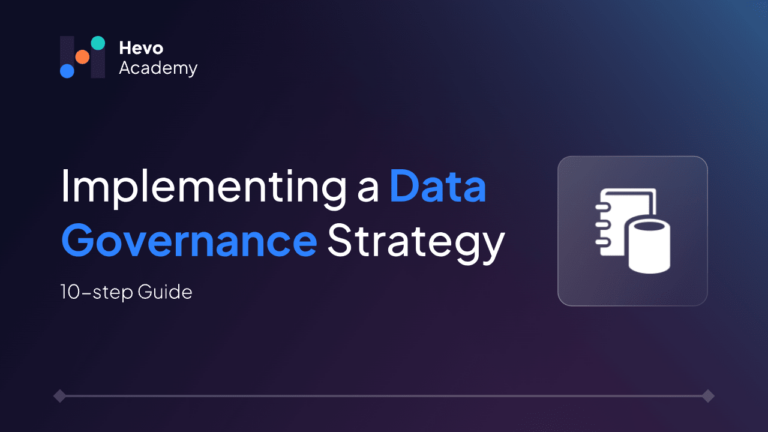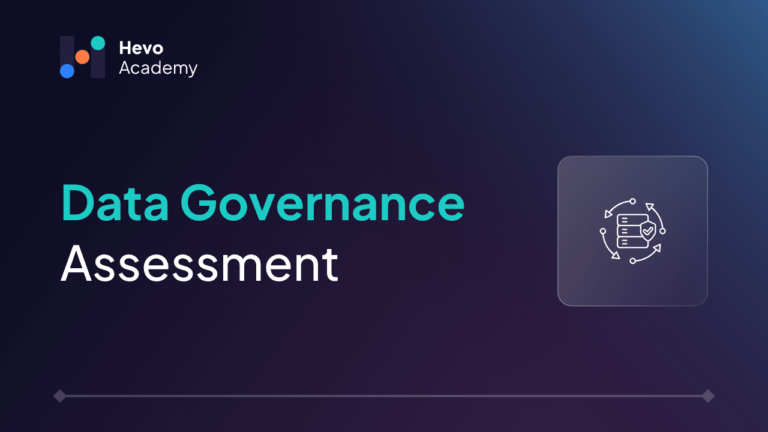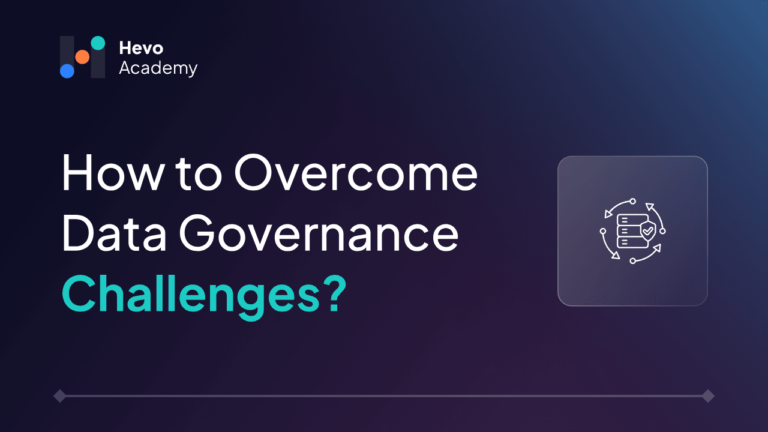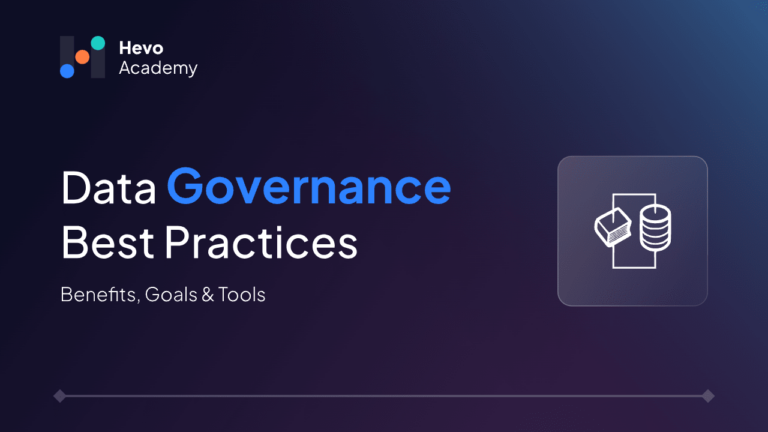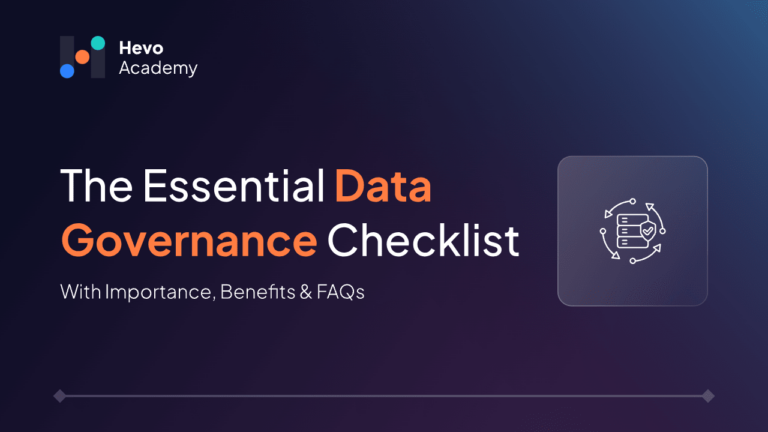A robust data governance strategy is essential for organizations that leverage data to drive business growth, improve decision-making, and achieve successful outcomes in a competitive market. As organizations collect vast amounts of internal and external data, a well-defined strategy is crucial for managing risks, reducing costs, and executing business objectives effectively.
Table of Contents
This article explores data governance strategies and the steps needed to ensure that data is appropriately used and maintained throughout its lifecycle.
While you focus on perfecting your data governance strategy, Hevo takes care of your data integration needs. With 150+ connectors and powerful in-flight transformations, Hevo seamlessly handles your data pipeline, allowing you to concentrate on governance.
Start your free trial today!
Get Started with Hevo for FreeWhat is Data Governance?
Data governance involves maintaining an organization’s data assets throughout its lifecycle, ensuring availability, high quality, and security. It requires a comprehensive framework of data management practices to ensure clients and customers trust that their information is handled in accordance with regulations and that teams can effectively use the gathered data. Balancing accessibility and security is at the heart of data governance.
Since data governance plays a significant role in supporting an organization’s goals, strategies must be tailored to meet specific needs. For example, healthcare focuses on compliance to ensure data privacy and adherence to HIPAA regulations. In retail, managing customer data involves balancing personalized marketing with privacy concerns. In manufacturing, the emphasis is on operational efficiency, data accuracy, and compliance with environmental and safety regulations. While fundamental principles of Gartner’s data governance—such as security, privacy, and compliance—are consistent across industries, the strategies and priorities vary based on data nature and regulatory requirements.
Key Elements of a Data Governance Strategy
To ensure successful implementation, focus on these five data governance principles:
- Accountability: Team members across the organization must take responsibility for data management. Without ownership, there is no effective data governance. Establish a data governance team with representatives from various departments to ensure cross-organization accountability.
- Data Quality: High-quality, clean, and reliable data is crucial for informed decision-making. Data stewards should create shared standards to improve data quality.
- Rules and Regulations: Develop standardized rules and regulations for data usage, created and enforced by the data governance team.
- Transparency: Maintain transparency in data governance processes by keeping permanent records of all functions and steps. This ensures that audits can verify data usage, handling, and rationale.
- Data Administration: Assign a dedicated data administrator, or data steward, responsible for enforcing data rules and regulations and reporting to the data governance team.
Quick Tip: Implementing data lineage as part of a data governance strategy allows organizations to enhance data transparency, ensuring that data flow aligns with governance policies.
Why is a Data Governance Strategy Important?
Organizations face significant challenges when managing their data assets, including:
- Inconsistent use of data across the organization: Different departments interpret and utilize data in various ways, creating confusion and misalignment.
- Poor data quality: This results in costly errors, rework, and inefficiencies, and it hampers organizational performance.
- Lack of transparency: A clear view of data assets may lead to misuse and uninformed decisions, hindering understanding and proper utilization of data.
- Compliance violations: Improper data classification and storage can lead to non-compliance with regulations, posing legal risks and potential penalties.
Data governance is essential for addressing these challenges. It provides a structured framework to ensure data consistency, security, and compliance.
Steps to Implement a Data Governance Strategy
Step 1. Define Governance Objectives
Define specific goals for the governance strategy, such as improving data quality, ensuring compliance, protecting sensitive data, or enhancing accessibility. Set measurable KPIs to track the strategy’s success, such as data accuracy rates, regulatory compliance, or user satisfaction.
Step 2. Assess Your Data Landscape
Once you have defined your business goals and objectives, the next step is to assess your data landscape.
- Step 2.1: Begin by taking a comprehensive inventory of all available data sources, internal (such as customer records, sales data, and operational data) and external (like social media data, weather data, and economic indicators).
- Step 2.2: Identify which datasets are most relevant to your goals, considering their quantity and quality. Even a large volume of data can be ineffective if incomplete, inconsistent, or inaccurate, while a smaller amount of high-quality data can provide valuable insights if properly analyzed.
- Step 2.3: Understanding the format and structure of your data is crucial. Determine whether it is stored in a centralized data warehouse or spread across multiple systems and whether it is structured or unstructured. This understanding will guide you in integrating and analyzing the data effectively.
- Step 2.4: Ensure the data is cleaned, transformed, and integrated by standardizing formats, removing duplicates, and addressing missing values. Accurate, consistent, and complete data is essential for a strong foundation for successful data governance.
Step 3. Centralize and Transform Metadata for Effective Management
Data silos occur when departments manage separate databases for metadata, hindering the sharing and reuse of metadata assets. Centralizing metadata storage is essential for integrating data across platforms, maintaining visibility into data history, and ensuring strong governance.
A centralized approach supports scalability and helps departments understand data lineage. For effective centralized metadata management, consider using cloud platforms like AWS Glue, which offer scalable and flexible solutions.
Preparing and transforming metadata involves cleansing and validating it—removing outliers, filling in missing values, and standardizing formats—and creating templates for a business glossary, data dictionary, and business metadata to ensure consistency and track assets.
Step 4. Build your Data Governance Program
Align your objectives with existing people, processes, and technology capabilities to effectively build your data governance program.
People, Processes, and Technology capabilities refer to the key components necessary for implementing and managing an effective data governance program:
- People: This encompasses the roles, skills, and expertise required to manage and govern data. It includes data stewards, data owners, and governance teams responsible for implementing and enforcing data policies and practices.
- Processes: These are the established workflows and procedures for managing data throughout its lifecycle. This includes data quality management, integration, security, and compliance processes that ensure data is handled consistently and according to governance policies.
- Technology: This refers to the tools and systems used to support data management and governance. It includes data management platforms, data integration tools, metadata management systems, and data analytics tools that facilitate the storage, processing, and analysis of data.
Quick Tip: Incorporating an enterprise data catalog into your data governance strategy can strengthen data access control and improve data asset tracking, helping organizations achieve better data compliance and quality standards.
Step 5. Assign Data Governance Roles
Identify key stakeholders and roles for the data governance program, including employees, managers, IT staff, data architects, and data custodians. Establish the following roles:
- Executive Sponsor: A senior leader who champions data governance and supports the required investment.
- Data Governance Office (DGO): A central office to coordinate activities, track progress, and provide support.
- Data Owners and Stewards: Individuals responsible for data quality, compliance, and adherence to policies within their domains.
Step 6. Adopt Data Management Frameworks
Utilize data management frameworks like the EDM Council’s DCAM and Microsoft’s Cloud Data Management Capabilities (CDMC) to benchmark data maturity and adopt industry best practices.
- Data Management Capability Assessment Mode(DCAM): enables organizations to trust that their data and analytics programs are built on industry best practices and have been proven across the industry.
- Cloud Data Management Capabilities (CDMC): The CDMC frameworks help organizations effectively protect sensitive data in the cloud and enable trust for data consumers. They also help your organization better understand business needs for data management and define best practices for a hybrid-cloud world. One example is adopting Microsoft Purview, where data control compliance can be assessed for each data asset across all CDMC controls using a Python script to check compliance, then update assets with compliance scores through Microsoft Purview’s API.
Step 7. Implementing Data Privacy and Protection Measures
Implement security measures to protect against data breaches, ransomware, and cyberattacks. Develop data privacy and protection strategies that comply with data protection laws (e.g., GDPR, CCPA). Ensure processes are in place for data anonymization, data masking, and user consent management.
Step 8. Continuously Monitor and Improve Your Strategy
Review and adapt your strategy regularly to ensure it meets goals and business objectives. This will allow your data governance program to evolve and adapt to the changing needs of the organization and the industry. An approach of continuous improvement will enable your data governance program to stay relevant and deliver maximum value to the organization.
Step 9. Leveraging Technology for Data Governance
Integrate advanced AI and machine learning technologies to enhance data governance efforts. These technologies can automate data classification, compliance monitoring, and anomaly detection.
Step 10. Create a Distribution Process
The last step in data governance is determining how to distribute sensitive data. A reliable process and defined channels for distribution will foster smoother communication. To mitigate regulatory risks, organizations should embed data governance policies into everyday workflows by ensuring proper employee onboarding, training on usage policies, encouraging knowledge sharing, and establishing clear processes for requesting and implementing changes.
How to Measure Data Governance Success?
Evaluate the success of your data governance program using various KPIs and metrics:
- Data Quality Metrics: Measure accuracy, completeness, consistency, timeliness, and uniqueness.
- Data Security and Compliance: Monitor reductions in security incidents and breaches.
- Data Governance Maturity: Assess progress using maturity models.
- Data Assets and Adoption Usage: Track data catalog usage and data lineage software.
- Data Impact and Value: Measure improvements in business metrics such as revenue, cost savings, and customer satisfaction.
- Data Governance Costs and ROI: Measure cost reductions and ROI achieved through governance initiatives.
- Data Compliance: Assess results of internal and external audits.
- Roadmap Milestones: Track progress against planned milestones and initiatives.
Conclusion
To implement an effective data governance strategy, define clear business objectives and KPIs. Assess your data landscape and centralize and transform metadata. Assign key roles and utilize standardized data management frameworks such as DCAM and CDMC. Adopt robust security measures, continuously monitor and adapt your strategy, and establish a reliable distribution process. Regularly measure success to ensure the strategy aligns with business goals and industry standards.
In summary, data governance provides the essential framework and practices that ensure data is accurate, accessible, secure, and compliant. These are all critical for the successful execution of a data strategy. By addressing these areas, data governance supports and enhances the strategic use of data to achieve business objectives and drive growth. Schedule a personalized demo with Hevo for seamless data integration.
FAQs on Data Governance Strategy
1. What are the risks of poor data governance?
Poor data governance can result in data breaches, regulatory penalties, loss of customer trust, inefficient operations, and poor decision-making due to unreliable data.
2. What are the steps to implement a data governance strategy?
Key steps include defining governance objectives, assessing the data landscape, centralizing metadata, assigning governance roles, building a governance program, adopting security measures, and continuously monitoring the strategy.
3. How can organizations measure the success of a data governance strategy?
Success can be measured through KPIs such as data quality metrics, compliance rates, security incident reduction, data usage and adoption, and the overall impact on business performance.
4. How do defensive and offensive data strategies differ?
Defensive data strategies focus on protecting data, ensuring compliance, and mitigating risks, while offensive data strategies aim to leverage data for business growth, innovation, and competitive advantage.
5. What are some tools that support data governance?
Tools like data catalogs, metadata management systems, and compliance monitoring platforms (e.g., AWS Glue, Microsoft Purview) help organizations manage, secure, and govern their data assets effectively.
.

